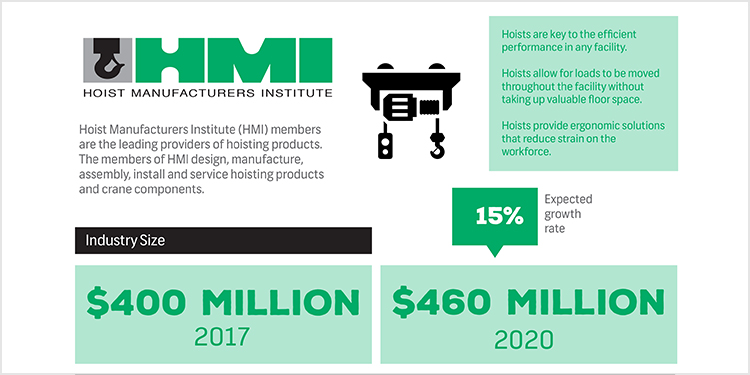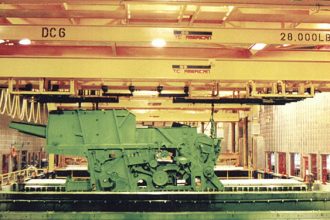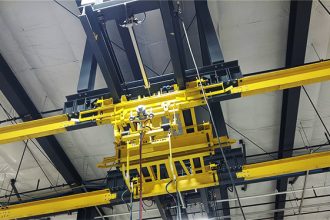Get The Quick Facts On Hoists And Their Use In New Infographic From HMI

If you’re looking for a quick overview of how hoists contribute to efficiency and performance in both manufacturing and distribution operations, look no further than the quick reference infographic from the Hoist Manufacturers Institute (HMI). The publication highlights the main kinds of industrial overhead hoists, the benefits they deliver, and the overall size—and increasing growth—of the hoist market. It also details the range of industries benefitting from overhead material handling systems, as well as introduces the library of resources offered by HMI.
Overhead hoists are used for vertical lifting of freely suspended, unguided loads. The graphic explains that hoists allow for items to be moved throughout an operation without taking up valuable floorspace. That’s because they enable their payloads to be transported overhead. Other benefits of hoist-based overhead handling include efficient and precise load handing; enhanced worker safety and ergonomics; and increased operational performance and throughput.
For these reasons, the hoist market is expected to grow by 15% to $460 million in 2020 (from $400 million in 2017), according to the document. And it’s no wonder, considering how many manufacturing and warehousing facilities across a broad range of industries rely on hoists (and cranes) for materials movement. These include warehousing and distribution, production, machinery assembly, general manufacturing, building products, pulp and paper, automotive, food and beverage, utilities, fuel and power products, construction materials and sites, ship building and many more.
Three types of hoists are illustrated in the publication:
- Wire Rope – Utilizing a wire rope to lift or lower a load, these hoists are driven by electricity or air.
- Chain – Outfitted with either link or roller chain to lift or lower a load, these hoists can be manually operated, pneumatically driven or electric powered.
- Lever – Operated manually by someone who raises or lowers a lever to activate a ratchet and pawl configuration, this action enables the hoist to lift or lower the load incrementally, or to apply or release tension. They can be equipped with a chain, rope or web strap.
The graphic notes that mass production of the first powered hoists started in the early 1900s, and that today’s models are mostly still mass produced—although some are customized to accommodate specific applications. They can be powered by electricity, air or manually, as well as equipped with sophisticated controls for positioning, speed control, automation, and to deliver downloadable maintenance data. The latest hoists also sport Industry 4.0 and Industrial Internet of Things (IIoT) connectivity, enabling them to communicate with other operational systems and software for monitoring of performance and maintenance requirements.
HMI members represent the industry’s leading suppliers of hoisting equipment. They design, manufacture, assemble, install, and service hoists and crane components. Collectively, HMI members have a combined manufacturing and installation experience that spans more than 300,000 hoists per year. They are committed to providing products that deliver both exceptional value and proper load handling with a focus on safety and innovation. The organization offers a variety of resources—including a comprehensive library of product guides; a hoist certification program; OSHA Alliance safety tip sheets, fact sheets and quick cards; multiple technical papers and more—via its website at www.MHI.org/hmi.
Want your own copy of the HMI Hoist Infographic? It’s available as a free download, here. Additionally, HMI’s two partners in MHI’s Overhead Alliance—the Crane Manufacturers Association of America (CMAA) and the Monorail Manufacturers Association (MMA)—have published similar infographics, with CMAA’s here and MMA’s here.



